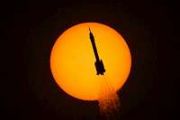
Copernical Team
Isolation and bed rest volunteers sought for future spaceflight research
 DLR and ESA are recruiting volunteers for two human research campaigns at the :envihab aerospace medicine facility in Cologne that will simulate key aspects of long duration missions beyond low Earth orbit. The SOLIS100 isolation study will place six participants in a confined, spacecraft like habitat for 100 days, while the SMC3 bed rest study will keep 12 volunteers in head down tilt for 60 da
DLR and ESA are recruiting volunteers for two human research campaigns at the :envihab aerospace medicine facility in Cologne that will simulate key aspects of long duration missions beyond low Earth orbit. The SOLIS100 isolation study will place six participants in a confined, spacecraft like habitat for 100 days, while the SMC3 bed rest study will keep 12 volunteers in head down tilt for 60 da Martian butterfly crater reveals low angle impact and buried lava history
 ESA's Mars Express orbiter has observed an impact crater in Mars's northern lowlands whose shape resembles a butterfly, created when an incoming space rock struck the surface at a shallow angle. The main crater, which appears somewhat like a walnut from orbit, measures about 20 km east to west and 15 km north to south and sits within the Idaeus Fossae region. The impact threw material preferenti
ESA's Mars Express orbiter has observed an impact crater in Mars's northern lowlands whose shape resembles a butterfly, created when an incoming space rock struck the surface at a shallow angle. The main crater, which appears somewhat like a walnut from orbit, measures about 20 km east to west and 15 km north to south and sits within the Idaeus Fossae region. The impact threw material preferenti SwRI links Uranus radiation belt mystery to solar storm driven waves
 SwRI scientists report that a reanalysis of Voyager 2 measurements suggests a powerful solar storm may explain why Uranus hosts an electron radiation belt far more intense than expected. They propose that a large-scale solar wind structure, known as a co-rotating interaction region, was passing through the Uranian system during the 1986 flyby, driving extreme space weather conditions that booste
SwRI scientists report that a reanalysis of Voyager 2 measurements suggests a powerful solar storm may explain why Uranus hosts an electron radiation belt far more intense than expected. They propose that a large-scale solar wind structure, known as a co-rotating interaction region, was passing through the Uranian system during the 1986 flyby, driving extreme space weather conditions that booste Vast spinning galaxy filament mapped in nearby Universe
 An international collaboration led by the University of Oxford has identified one of the largest rotating structures observed so far, a thin string of hydrogen-rich galaxies embedded in a spinning cosmic filament around 140 million light-years away. The work, published in Monthly Notices of the Royal Astronomical Society, offers new constraints on how large-scale structures influence the formati
An international collaboration led by the University of Oxford has identified one of the largest rotating structures observed so far, a thin string of hydrogen-rich galaxies embedded in a spinning cosmic filament around 140 million light-years away. The work, published in Monthly Notices of the Royal Astronomical Society, offers new constraints on how large-scale structures influence the formati Trump NASA nominee aims to beat China in new moon race
Verifying that you are not a bot
Space debris poses growing threat, but new study suggests cleanup is feasible
Verifying that you are not a bot
A blueprint for visiting an interstellar comet
Verifying that you are not a bot
Comet 3I/ATLAS shows activity in Juice navigation camera teaser
 Image:
Comet 3I/ATLAS shows activity in Juice navigation camera teaser
Image:
Comet 3I/ATLAS shows activity in Juice navigation camera teaser Rolling out the red carpet for Mars
 Image:
ExoMars ramps hinge
Image:
ExoMars ramps hinge Martian dust devils found to generate electrical sparks
 Electric discharges have been detected inside dust devils and dust storms on Mars for the first time, using sound recordings from the SuperCam microphone on NASAs Perseverance rover. Scientists from CNRS, Universite de Toulouse and Observatoire de Paris PSL analysed these signals and identified them as the acoustic and electromagnetic signatures of electrical activity within Martian dust events.
Electric discharges have been detected inside dust devils and dust storms on Mars for the first time, using sound recordings from the SuperCam microphone on NASAs Perseverance rover. Scientists from CNRS, Universite de Toulouse and Observatoire de Paris PSL analysed these signals and identified them as the acoustic and electromagnetic signatures of electrical activity within Martian dust events. 






























